Tight, dry, and hard, pizza dough that won’t stretch, does this sound familiar? We’ve all experienced that, and it’s extremely frustrating. So I spent some time digging into what makes pizza dough stretchy. And here is what I found – the secret to perfectly stretchy pizza dough.
The main reason your pizza dough is not stretchy is improper gluten development, the gluten strands are too tight due to too little time to relax, you’re using the wrong type of flour, the dough is too dry, or the dough is too cold.
- You use the wrong flour
- Too much or too little kneading (over and underdevelopment of gluten)
- The dough is not relaxed enough
- Too dry dough
- Too cold dough
Gluten is the cause of all your trouble
The most common reason your dough isn’t stretchy is related to gluten.
Gluten is a group of proteins found in wheat flour that helps keep the dough together. The gluten in the flour starts developing a network when you add water and knead the dough. This network grows stronger and stronger the more you knead the dough. Hydration also helps gluten development over time. So for long, slow fermentation, the gluten will develop even without kneading.
If the gluten network develops too much, the dough will be elastic and hard to stretch. If it develops too little, the dough will tear if you try to stretch it. So the key is to have just the right amount of gluten development.
Why gluten development is important
You want the gluten network to develop for three reasons:
- Give the dough structure
- Trap gas from the fermentation
- Make the dough together
If the gluten hasn’t developed enough, the dough will puncture and not be able to hold onto CO2 produced by the yeast during fermentation. The dough will also be hard to stretch and launch into the oven without making holes in the pizza.
The main factors that affect how strong or weak the gluten network gets: are the amount of gluten in the flour, how much you knead the dough, and how long it’s left to rise. So you have to start with the right type of flour and the right amount of kneading.
But the strength of the gluten network isn’t the only thing that affects the stretchiness of the dough. When you knead the dough, the gluten strands get tense. When the gluten is tense the dough gets elastic and hard to stretch. But if you leave the dough to rest, the gluten will get relaxed and the dough gets easier to stretch.
So you want a strong gluten network that prevents tearing, but you also need to let the gluten relax. This will give you a dough that’s soft pliable, and easy to stretch.
If you want a deep dive into the topic of gluten, check out this article.
What makes pizza dough stretchy?
The balance between gluten development, and how relaxed the gluten is are the main factors in how stretchy the dough is.
It’s all about the flour
To make good pizza, you have to start with good flour. Ideal gluten development starts with flour with the right gluten content.
The optimal amount of gluten is around 11-13%. If you use cake flour, that’s low in gluten, you’ll end up with a weak dough that’s not going to hold up during proofing. And if you’re using bread flour, that’s high in gluten, you’ll end up with a dough that’s too elastic. You should therefore aim for something in between – Tipo pizza flour.
The best type of pizza flour is Italian Tipo 0 or Tipo 00 flour. This is also what’s recommended by The True Neapolitan Pizza Association, which defined standards for Neapolitan pizza.
Pizza flours vary in quality and gluten content. But most Italian Tipo 0 or Tipo 00 will be in the 11-13% range and give a great result.
A great all-around pizza flour is Caputo Pizzeria. Caputo Pizzeria is Tipo 00 flour milled in Naples, Italy. This is a high-quality flour used by many pizzerias in Naples, that has just the right amount of gluten.
A relaxed dough is easier to stretch
The most common reason your pizza dough is too stretchy is that the gluten is too tense. When you knead the dough, and the gluten network is getting stronger, it also tightens up. A relaxed dough is much easier to stretch.
One of the most common mistakes people make is to bulk ferment their dough, split it into dough balls, and try to stretch out the dough straight away. When you split the dough, and make dough balls, the gluten will tighten up. You, therefore, need to let the dough balls rest again to make the dough soft and stretchy. You’ll then find it’s much easier to shape your pizza.
How long the dough needs to relax depends on the style of pizza and your stretching technique. But you need to let the dough rest for at least 30 minutes to 1 hour before you stretch out your pizza.
For Neapolitan pizza, you should let the dough balls rest for 8-10 hours. This will give soft, nice dough that you easily can stretch into thin, even discs.
The longer you leave the dough balls, the softer and stretchier the dough is going to be. And it can become hard to handle the dough without stretching the pizza base too thin.
Under kneading – lack of gluten development
If you don’t knead your dough enough, the gluten will not develop enough to get a proper structure. The dough will then not be able to keep its shape. It will also deflate when you let it rise, and it will rip and tear when you try to stretch it. So you have to knead the dough enough, to get it elastic and stretchy.
When you’re kneading by hand the dough needs around 15 to 20 minutes for the gluten to fully develop.
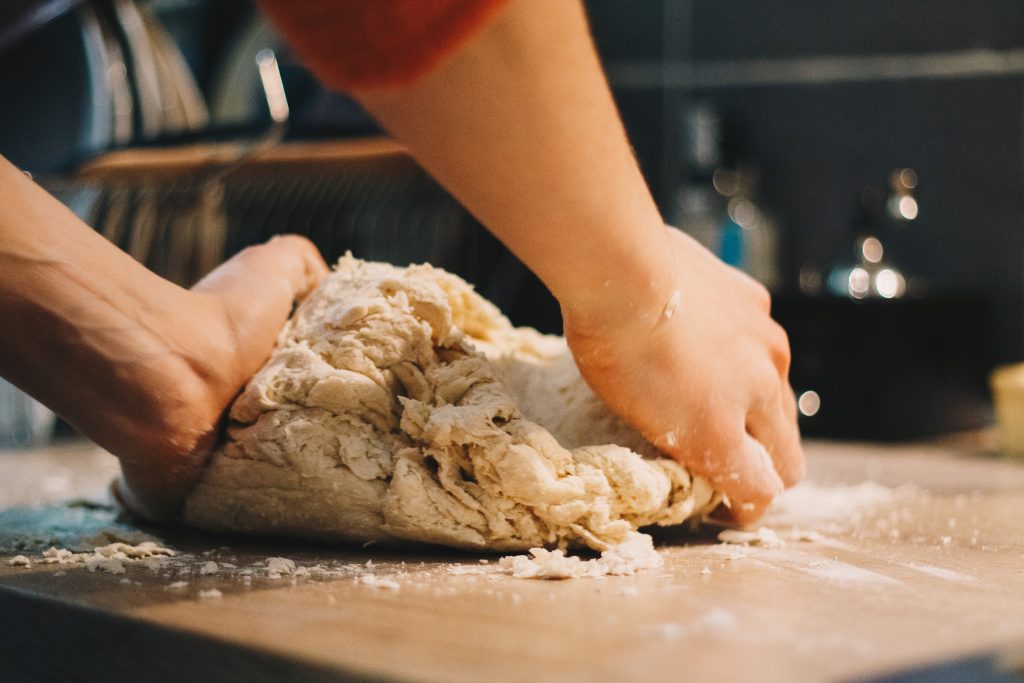
Autolyse will make the dough more stretchy
The gluten also needs to be fully hydrated to develop properly. To ensure it fully develops, you can use a technique called autolyse.
Simply mix the ingredients and let the dough hydrate for 15-30 minutes before kneading. This short rest gives the flour enough time to hydrate, gluten starts to develop, and the amylase enzymes start turning starch into sugars and giving the yeast a headstart. This will make a nice, extensible, and stretchy dough. And it will also reduce the kneading time a bit.
This is however not necessary for Neapolitan and other long-rise doughs (such as cold fermented pizza), since the gluten will get hydrated enough during the long leave.
How to tell if gluten has developed enough
The two most common ways to check if the dough gluten has developed enough are The Poke Test and The Windowpane Test.
The PoketTest
The way to perform The Poke Test is simply to poke the dough with your index finger and see if it springs back. If it does, this means that gluten has developed enough, and is strong enough to keep the shape of the dough.
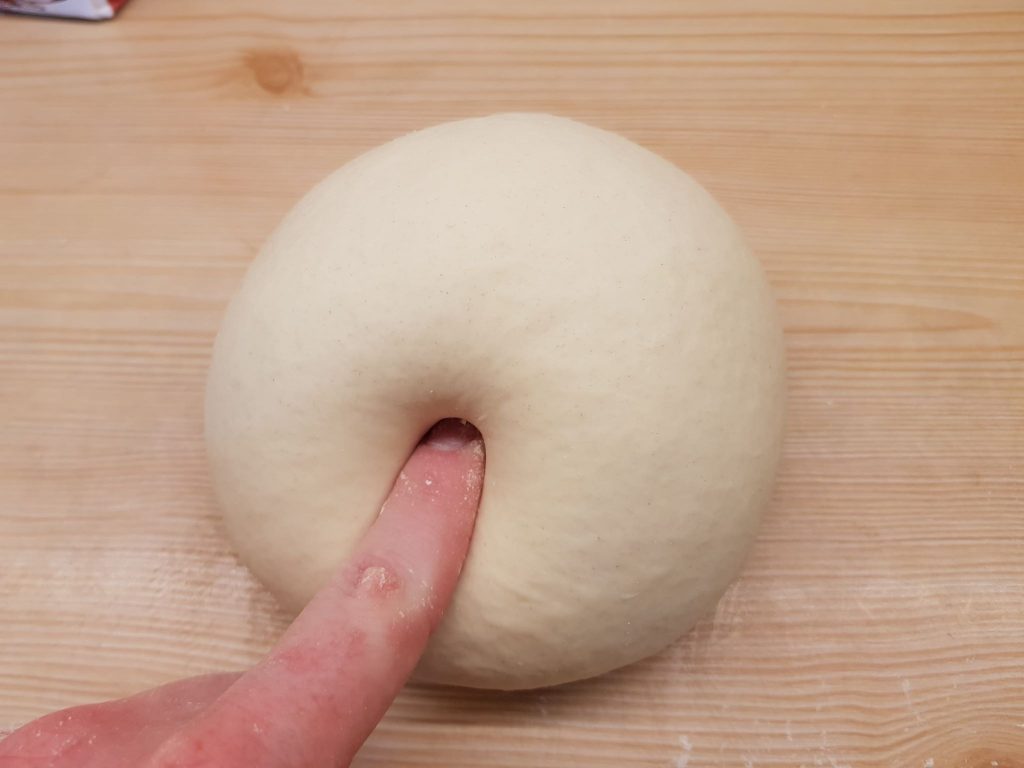
The Windowpane test
The other way to check if the gluten has developed enough is The Windowpane Test. Take a small piece of dough, and stretch it out as thin as possible without making a hole in the dough. If the gluten has developed enough, you will be able to stretch it so thin that you can see light going through the dough. This is an indication the gluten is strong enough.
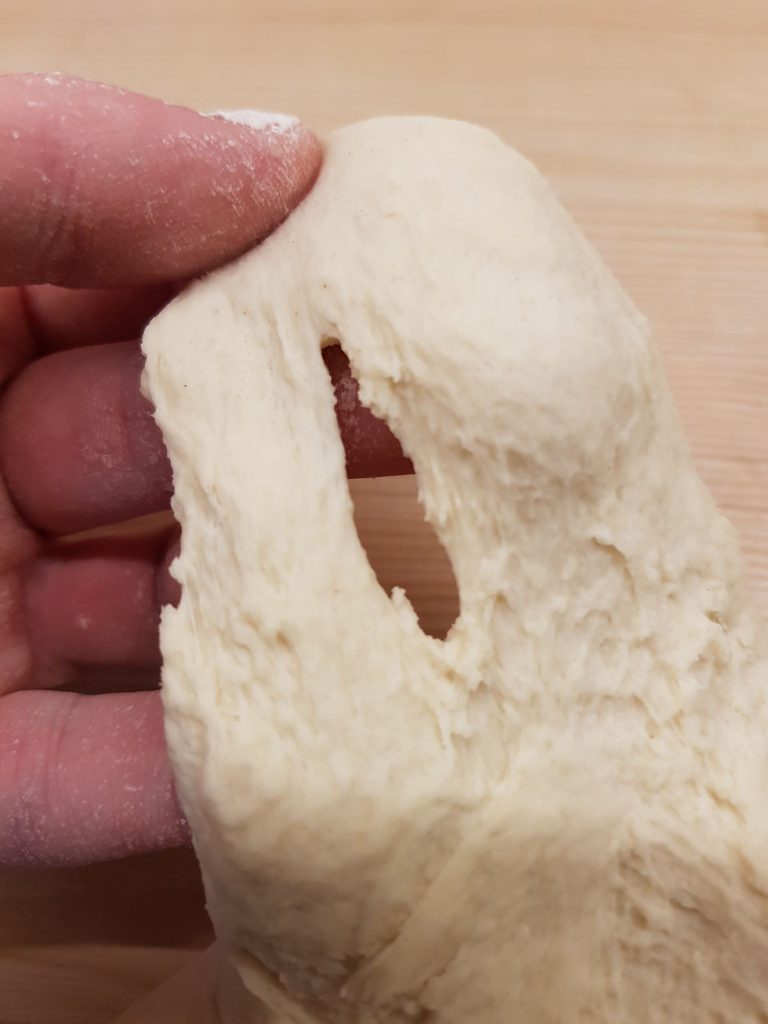
Over kneading – the gluten is too strong to stretch
The other thing that can go wrong with gluten is overdevelopment. This means that you’ve worked the gluten too much. And made the network so strong that it’s hard to stretch your dough.
It’s hard to do by hand. So don’t worry too much if you’re kneading by hand.
If you’re using a stand mixer, I recommend running it in 5-minute intervals. Then use the poke or windowpane test to check if the gluten has developed enough. It’s also better to give the dough a break since a stand mixer will increase the temperature of the dough if you run it for too long.
Hydration
Another reason your dough is not stretchy is that it has too low hydration.
What is Hydration?
Dough hydration is the amount of water compared to the amount of flour. The higher the hydration (the more water your dough contains), the softer and more stretchy the dough will be.
What Is the Best Hydration for Stretchy Pizza Dough?
The best hydration for stretchy pizza dough is 60-65%. You can go even higher, but that will make the dough sticky, and hard to work with. 60-65% is, therefore, a good starting point.
Temperature
Cold dough is also hard to stretch. When the gluten gets cold, it also tightens up. And when it’s hot it gets soft.
The dough is typically easiest to handle when at room temperature, in the 70-75°F (21-24°C) range.
So if you make cold fermented pizza dough, that you store in the fridge, it’s important to let it come to temperature before you try to stretch it. The dough will feel much harder when it’s cold, and that’s going to make it hard to shape your pizza. So, take the dough out from the fridge and leave it out for 2-3 hours to come to room temperature before stretching out the pizza.
If you, leave the dough in a hot room to ferment, you might find the gluten to be too soft and relaxed. Then you can stick the dough in the fridge for 15-20 minutes to cool it down to make it easier to handle during stretching.
Related
- Is Your Pizza Dough Too Dry? Here is How to fix it! - June 10, 2024
- The Ultimate Guide to the Pizza Dough Windowpane Test - June 8, 2024
- The Ultimate Guide to Autolyse Pizza Dough - June 7, 2024

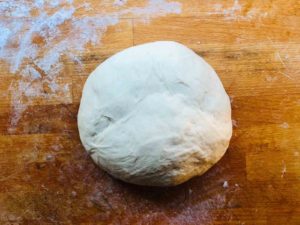
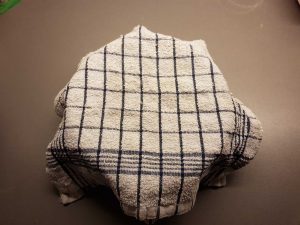
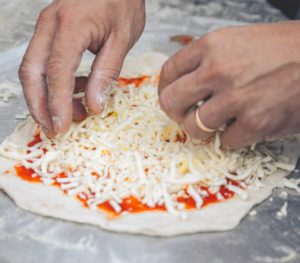


Great insight into making pizza dough. It reaffirmed some of the knowledge I already had.
Thanks,
This is very helpful information! I’ve been making homemade pizza/pizza dough for a few months now without properly researching and it hasn’t been easy to work the dough. This helps a lot so thank you!
I’m happy to hear that! 🙂
I got my husband a pizza oven for Christmas, we’ve been making pizzas about every other week since, and we haven’t been able to get the dough right yet. Your tips have shed a lot of light on what I’ve been doing wrong. Thanks for the insights!
I have been autolysing my 00 flour for about an hour, kneading for 10 minutes, bulk fermenting for an hour, dividing and putting in the fridge, taking out 2 hours before stretching/cooking.
My dough is good but not great. It tears easily when stretching and tastes a little tight and leathery.
Should I just knead for longer?
What kind of dough do you make? How long do you leave your dough in the fridge? And what types of flour do you use? Is the dough stretching easily?
It’s hard to say without a little more details about the dough, fermentation and your recipe, but if the dough tears, it sounds like the flour might have too little gluten.
With autolyse + 10 minutes of kneading + an extended leave (I assume) in the fridge, the gluten should develop enough. So my guess is that you use weak flour. Longer fermentation times need stronger flour with more gluten.
Thanks Andreas.
I’m using a bread flour that I also make sourdough with. It’s from a bread making shop and claims to be 12% protein.
I have actually had better results with an Italian 00 flour that is only 11.5% protein.
Depending on what time I mix the dough it can spend between 4 and 6 hours in the fridge, then always at least 2 hours coming beck to room temp before stretching.
Thanks Andreas.
I’m using a bread flour that I also make sourdough with. It’s from a bread making shop and claims to be 12% protein.
I have actually had better results with an Italian 00 flour that is only 11.5% protein.
Depending on what time I mix the dough it can spend between 4 and 6 hours in the fridge, then always at least 2 hours coming beck to room temp before stretching.
Yes! Your advice took my standard pizza dough recipe from tough to tender!
You keep saying about the dough being “difficult” to stretch…….by “difficult”, do you mean that it won’t stay stretched, that it “pulls back”???
Well THAT’S my problem, with every dough I’ve tried, whether I buy it from Italian supermarkets, or Italian Restos, whether I buy it frozen, or not!!!
I hand stretch it, I roll it, but it always snaps back!!!!
HELP ME PLEASE !!!!!
If your dough is too elastic and pulls back, you have to let the dough rest longer. When you let the dough rest, the gluten will relax and get soft and pliable. Also make sure your dough is at room temperature. Cold dough is much tougher to work with.
Brilliant advice!! I followed your instructions, mainly leaving the mixed dough for 30 minutes before kneading (I never did that before) and kneading for 20 minutes (I did 10 minutes). I also left the dough to prove in one ball, then divided into to two just before stretching. This time, I divided into balls immediately after kneading and left to prove for 8 hours. I was skeptical but the difference was amazing. For the first time in two years of making my own dough, I was able to stretch the dough perfectly. Thanks so much for your expertise!!